Thermal Stabilization of Nafion with Nanocarbon Materials
Abstract
:1. Introduction
2. Materials and Methods
2.1. The Following Materials Were Used in the Experiments
2.2. Differential Thermal Studies
2.3. Microscopic Studies
2.4. XPS
2.5. Calculation and Processing of Results
3. Results and Discussion
3.1. Nafion Destruction Thermal Effects
3.2. XPS Study
4. Conclusions
Author Contributions
Funding
Institutional Review Board Statement
Data Availability Statement
Acknowledgments
Conflicts of Interest
References
- Dubau, L.; Castanheira, L.; Maillard, F.; Chatenet, M.; Lottin, O.; Maranzana, G.; Dillet, J.; Lamibrac, A.; Perrin, J.C.; Moukheiber, E.; et al. A review of PEM fuel cell durability: Materials degradation, local heterogeneities of aging and possible mitigation strategies. Wiley Interdiscip. Rev.-Energy Environ. 2014, 3, 540–560. [Google Scholar] [CrossRef]
- Wu, J.; Yuan, X.Z.; Martin, J.J.; Wang, H.; Zhang, J.; Shen, J.; Wu, S.; Merida, W. A review of PEM fuel cell durability: Degradation mechanisms and mitigation strategies. J. Power Sources 2008, 184, 104–119. [Google Scholar] [CrossRef]
- Borup, R.; Meyers, J.; Pivovar, B.; Kim, Y.S.; Mukundan, R.; Garland, N.; Myers, D.; Wilson, M.; Garzon, F.; Wood, D.; et al. Scientific aspects of polymer electrolyte fuel cell durability and degradation. Chem. Rev. 2007, 107, 3904–3951. [Google Scholar] [CrossRef]
- Bruijn, F.A.; Dam, V.A.T.; Janssen, G.J.M. Review: Durability and Degradation Issues of PEM Fuel Cell Components. Fuel Cells 2008, 8, 3–22. [Google Scholar] [CrossRef]
- Sugawara, T.; Kawashima, N.; Murakami, T.N. Kinetic study of Nafion degradation by Fenton reaction. J. Power Sources 2011, 196, 2615–2620. [Google Scholar] [CrossRef]
- Robert, M.; El Kaddouri, A.; Perrin, J.-C.; Mozet, K.; Dillet, J.; Morel, J.-Y.; Lottin, O. The Impact of Chemical-Mechanical Ex Situ Aging on PFSA Membranes for Fuel Cells. Membranes 2021, 11, 366. [Google Scholar] [CrossRef] [PubMed]
- Menshchikov, V.; Alekseenko, A.; Guterman, V.; Nechitailov, A.; Glebova, N.; Tomasov, A.; Spiridonova, O.; Belenov, S.; Zelenina, N.; Safronenko, O. Effective Platinum-Copper Catalysts for Methanol Oxidation and Oxygen Reduction in PEM FC. Nanomaterials 2020, 10, 742. [Google Scholar] [CrossRef]
- Glebova, N.V.; Nechitailov, A.A.; Krasnova, A.O. Thermal Degradation of Nafion in the Presence of Nanostructured Materials: Thermally Expanded Graphite, Carbon Black, and Platinum. Russ. J. Appl. Chem. 2020, 93, 1034–1041. [Google Scholar] [CrossRef]
- Glebova, N.V.; Krasnova, A.O.; Nechitailov, A.A. The Evolution of Mass-Transport Properties of Structurally Modified Electrodes with Mixed Conductivity. Technol. Phys. 2022, 67, 14–22. [Google Scholar] [CrossRef]
- Nechitailov, A.A.; Glebova, N.V.; Krasnova, A.O. Structure formation model in the Pt/C-CNT-Nafion system. J. Struct. Chem. 2019, 60, 1507–1519. [Google Scholar] [CrossRef]
- Danerol, A.S.; Bas, C.; Flandin, L.; Claude, E.; Alberola, N.D. 2011 Influence of ageing in fuel cell on membrane/electrodes interfaces. J. Power Sources 2011, 196, 3479–3484. [Google Scholar] [CrossRef]
- El Kaddouri, A. Mise en Evidence de la Dégradation du Liant Ionomere dans les Electrodes de pile à Combustible. Ph.D. Thesis, Mécanique, Génie Civil, électrochimie, École Doctorale Ingénierie—Matériaux Mécanique énergétique Environnement Procédés Production en Partenariat avec Laboratoire d’électrochimie et de Physicochimie des Matériaux et des Interfaces (Laboratoire). Université de Grenoble, Grenoble, France, 25 February 2014. [Google Scholar]
- Zhang, F.-Y.; Advani, S.G.; Prasad, A.K.; Boggs, M.E.; Sullivan, S.P.; Beebe, T.P. Quantitative characterization of catalyst layer degradation in PEM fuel cells by X-ray photoelectron spectroscopy. Electrochim. Acta 2009, 54, 4025–4030. [Google Scholar] [CrossRef]
- Parry, V.; Berthomé, G.; Joud, J.-C.; Lemaire, O.; Franco, A.A. XPS investigations of the proton exchange membrane fuel cell active layers aging: Characterization of the mitigating role of an anodic CO contamination on cathode degradation. J. Power Sources 2011, 196, 2530–2538. [Google Scholar] [CrossRef]
- Silva, R.A.; Hashimoto, T.; Thompson, G.E.; Rangel, C.M. Characterization of MEA degradation for an open air cathode PEM fuel cell. Int. J. Hydrogen Energy 2012, 37, 7299–7308. [Google Scholar] [CrossRef]
- Zatoń, M.; Rozière, J.; Jones, D.J. Current understanding of chemical degradation mechanisms of perfluorosulfonic acid membranes and their mitigation strategies: A review. Sustain. Energy Fuels 2017, 1, 409–438. [Google Scholar] [CrossRef]
- Karim, N.A.; Alias, M.S.; Shaari, N.; Yang, H. Calcium carbonate from chicken eggshells as filler in composite Nafion membrane for direct ethanol fuel cell: A molecular dynamics study. J. Chem. Technol. Biotechnol. 2023. [Google Scholar] [CrossRef]
- Hamid, N.S.A.; Kamarudin, S.K.; Karim, N.A. Potential of Nafion/eggshell composite membrane for application in direct methanol fuel cell. Int. J. Energy Res. 2021, 45, 2245–2264. [Google Scholar] [CrossRef]
- Coms, F.D.; Liu, H.; Owejan, J.E. Mitigation of Perfluorosulfonic Acid Membrane Chemical Degradation Using Cerium and Manganese Ions. ECS Trans. 2008, 16, 1735–1747. [Google Scholar] [CrossRef]
- Endoh, E. Highly durable PFSA membranes. In Handbook of Fuel Cells; Vielstich, W., Lamm, A., Gasteiger, H.A., Yokokawa, H., Eds.; John Wiley & Sons, Ltd.: Hoboken, NJ, USA, 2010. [Google Scholar] [CrossRef]
- Stewart, S.M.; Spernjak, D.; Borup, R.; Datye, A.; Garzon, F. Cerium Migration through Hydrogen Fuel Cells during Accelerated Stress Testing. ECS Electrochem. Lett. 2014, 3, F19–F22. [Google Scholar] [CrossRef]
- Trogadas, P.; Parrondo, J.; Ramani, V. Degradation Mitigation in Polymer Electrolyte Membranes Using Cerium Oxide as a Regenerative Free-Radical Scavenger. Electrochem. Solid-State Lett. 2008, 11, B113. [Google Scholar] [CrossRef]
- Pearman, B.P.; Mohajeri, N.; Brooker, R.P.; Rodgers, M.P.; Slattery, D.K.; Hampton, M.D.; Cullen, D.A.; Seal, S. The degradation mitigation effect of cerium oxide in polymer electrolyte membranes in extended fuel cell durability tests. J. Power Sources 2013, 225, 75–83. [Google Scholar] [CrossRef]
- Lim, C.; Alavijeh, A.S.; Lauritzen, M.; Kolodziej, J.; Knights, S.; Kjeang, E. Fuel Cell Durability Enhancement with Cerium Oxide under Combined Chemical and Mechanical Membrane Degradation. ECS Electrochem. Lett. 2015, 4, F29–F31. [Google Scholar] [CrossRef]
- Zhao, D.; Yi, B.L.; Zhang, H.M.; Yu, H.M. MnO2/SiO2–SO3H nanocomposite as hydrogen peroxide scavenger for durability improvement in proton exchange membranes. J. Membr. Sci. 2010, 346, 143–151. [Google Scholar] [CrossRef]
- Prabhakaran, V.; Arges, C.G.; Ramani, V. Investigation of polymer electrolyte membrane chemical degradation and degradation mitigation using in situ fluorescence spectroscopy. Proc. Natl. Acad. Sci. USA 2012, 109, 1029–1034. [Google Scholar] [CrossRef] [PubMed]
- D’Urso, C.; Oldani, C.; Baglio, V.; Merlo, L.; Aricò, A.S. Towards fuel cell membranes with improved lifetime: Aquivion® Perfluorosulfonic Acid membranes containing immobilized radical scavengers. J. Power Sources 2014, 272, 753–758. [Google Scholar] [CrossRef]
- Lutsyk, P.; Piryatinski, Y.; Shandura, M.; AlAraimi, M.; Tesa, M.; Arnaoutakis, G.E.; Melvin, A.A.; Kachkovsky, O.; Verbitsky, A.; Rozhin, A. Self-Assembly for Two Types of J-Aggregates: Cis-Isomers of Dye on the Carbon Nanotube Surface and Free Aggregates of Dye trans-Isomers. J. Phys. Chem. C 2019, 123, 19903–19911. [Google Scholar] [CrossRef]
- Lutsyk, P.; Piryatinski, Y.; AlAraimi, M.; Arif, R.; Shandura, M.; Kachkovsky, O.; Verbitsky, A.; Rozhin, A. Emergence of Additional Visible-Range Photoluminescence Due to Aggregation of Cyanine Dye: Astraphloxin on Carbon Nanotubes Dispersed with Anionic Surfactant. J. Phys. Chem. C 2016, 120, 20378–20386. [Google Scholar] [CrossRef]
- Vinothkannan, M.; Kim, A.R.; Kumar, G.G.; Yoo, D.J. Sulfonated graphene oxide/Nafion composite membranes for high temperature and low humidity proton exchange membrane fuel cells. RSC Adv. 2018, 8, 7494–7508. [Google Scholar] [CrossRef]
- Matos, B.; Aricó, E.; Linardi, M.; Ferlauto, A.; Santiago, E.; Fonseca, F. Thermal properties of Nafion–TiO2 composite electrolytes for PEM fuel cell. J. Therm. Anal. Calorim. 2009, 97, 591–594. [Google Scholar] [CrossRef]
- Cele, N.P.; Ray, S. Effect of multiwalled carbon nanotube loading on the properties of Nafion® membranes. J. Mater. Res. 2015, 30, 66–78. [Google Scholar] [CrossRef]
- Cele, N.P.; Ray, S.S.; Pillai, S.K.; Ndwandwe, M.; Nonjola, S.; Sikhwivhilu, L.; Mathe, M.K. Carbon Nanotubes Based Nafion Composite Membranes for Fuel Cell Applications. J. Fuel Cells 2010, 10, 64–71. [Google Scholar] [CrossRef]
- Wilberforce, T.; Abdelkareem, M.A.; Elsaid, K.; Olabi, A.G.; Sayed, E.T. Role of carbon-based nanomaterials in improving the performance of microbial fuel cells. Energy 2022, 240, 122478. [Google Scholar] [CrossRef]
- Tafete, G.A.; Thothadri, G.; Abera, M.K. A review on carbon nanotube-based composites for electrocatalyst applications. Fuller. Nanotub. Carbon Nanostruct. 2022, 30, 1075–1083. [Google Scholar] [CrossRef]
- Chen, T.-W.; Kalimuthu, P.; Veerakumar, P.; Lin, K.-C.; Chen, S.-M.; Ramachandran, R.; Mariyappan, V.; Chitra, S. Recent Developments in Carbon-Based Nanocomposites for Fuel Cell Applications: A Review. Molecules 2022, 27, 761. [Google Scholar] [CrossRef]
- Sharma, R.; Cherusseri, J.; Kar, K.K. Polymer electrolyte membrane fuel cells: Role of carbon nanotubes/graphene in cathode catalysis. In Handbook of Polymer Nanocomposites. Processing, Performance and Application; Kar, K.K., Pandey, J.K., Rana, S., Eds.; Springer: Berlin, Germany, 2015; pp. 361–390. [Google Scholar] [CrossRef]
- Ouyang, J. Applications of carbon nanotubes and graphene for third-generation solar cells and fuel cells. Nano Mater. Sci. 2019, 1, 77–90. [Google Scholar] [CrossRef]
- Ghosh, S.; Das, S.; Mosquera, M.E.G. Conducting polymer-based nanohybrids for fuel cell application. Polymers 2020, 12, 2993. [Google Scholar] [CrossRef]
- Bhosale, A.C.; Ghosh, P.C.; Assaud, L. Preparation methods of membrane electrode assemblies for proton exchange membrane fuel cells and unitized regenerative fuel cells: A review. Renew. Sustain. Energy Rev. 2020, 133, 110286. [Google Scholar] [CrossRef]
- Yamaguchi, M. Thermal desorption and pyrolysis direct analysis in real time mass spectrometry of Nafion membrane. J. Appl. Polym. Sci. 2021, 138, 50172. [Google Scholar] [CrossRef]
- De Volder, M.F.L.; Tawfick, S.H.; Baughman, R.H.; Hart, A.J. Carbon nanotubes: Present and future commercial applications. Science 2013, 339, 535–539. [Google Scholar] [CrossRef]
- Mazin, V.I.; Mazin, E.V. Method of Producing Porous Carbon Material Based on Highly Disintegrated Graphite. RF Patent 2,581,382, 20 April 2016. [Google Scholar]
- Pt Catalysts—Electrochemistry. Available online: http://www.premetek.com/pt-catalysts--electrochemical.html (accessed on 2 October 2019).
- Kachala, V.V.; Khemchyan, L.L.; Kashin, A.S.; Orlov, N.V.; Grachev, A.A.; Zalesskiy, S.S.; Ananikov, V.P. Target-oriented analysis of gaseous, liquid, and solid chemical systems with mass spectrometry, nuclear magnetic resonance spectroscopy, and electron microscopy. Russ. Chem. Rev. 2013, 82, 648–685. [Google Scholar] [CrossRef]
- Kastsova, A.G.; Glebova, N.V.; Nechitailov, A.A.; Krasnova, A.O.; Pelageikina, A.O.; Eliseyev, I.A. Electronic spectroscopy of graphene obtained by ultrasonic dispersion. Technol. Phys. Lett. 2022, 48, 60–62. [Google Scholar] [CrossRef]
- Deng, Q.; Wilkie, C.A.; Moore, R.B.; Mauritz, K.A. TGA–FTi.r. investigation of the thermal degradation of Nafion® and Nafion®/[silicon oxide]-based nanocomposites. Polymer 1998, 39, 5961–5972. [Google Scholar] [CrossRef]
- Fernandez-Carretero, F.J.; Compan, V.; Riande, E.J. Hybrid ion-exchange membranes for fuel cells and separation processes. J. Power Sources 2007, 173, 68–76. [Google Scholar] [CrossRef]
- Park, H.S.; Kim, Y.J.; Hong, W.H.; Choi, Y.S.; Lee, H.K. Influence of morphology on the transport properties of perfluorosulfonate ionomers/polypyrrole composite membrane. Macromolecules 2005, 38, 2289–2295. [Google Scholar] [CrossRef]
- Hawtin, P.; Lewis, J.B.; Moul, N.; Phillips, R.H. The Heats of Combustion of Graphite, Diamond and Some Non-Graphitic Carbons. Philos. Trans. R. Soc. A Math. Phys. Eng. Sci. 1966, 261, 67–95. [Google Scholar] [CrossRef]




| Composite Content (wt.:wt.) | T, °C | Note |
|---|---|---|
| Nafion (Figure 2a) | 341, 413, 430 | three stages of degradation |
| Nafion:CNTs, 1:1 | 348, 409 | two stages of degradation |
| Nafion:CNTs, 1:4 (Figure 2a) | 376 | degradation combined in one stage |
| Nafion:TEG, 1:1 | 353 | degradation combined in one stage |
| Nafion:TEG, 1:4 (Figure 2a) | 422 | degradation combined in one stage |
| Nafion:Pt/C, 1:1.5 | 304 | degradation combined in one stage |
| Nafion:CNTs:Pt/C, 1:4.5:4.5 (Figure 2b) | 325, 335 | two stages of degradation |
| Nafion:TEG:Pt/C, 1:4.5:4.5 (Figure 2b) | 345 | degradation combined in one stage |
| Nafion Composite: CNM (wt.: wt.) | Combustion Interval, °C | Combustion Interval Width, ΔT, °C | ΔH, kJ/g |
|---|---|---|---|
| Nafion | 260–560 | 300 | 2.14 |
| Nafion:CNTs, 1:1 | 330–430 | 100 | 3.15 |
| Nafion:CNTs, 1:4 | 290–450 | 160 | 3.30 |
| Nafion:TEG, 1:1 | 430–460 | 130 | 2.24 |
| Nafion:TEG, 1:4 | 380–440 | 60 | 1.54 |
Disclaimer/Publisher’s Note: The statements, opinions and data contained in all publications are solely those of the individual author(s) and contributor(s) and not of MDPI and/or the editor(s). MDPI and/or the editor(s) disclaim responsibility for any injury to people or property resulting from any ideas, methods, instructions or products referred to in the content. |
© 2023 by the authors. Licensee MDPI, Basel, Switzerland. This article is an open access article distributed under the terms and conditions of the Creative Commons Attribution (CC BY) license (https://creativecommons.org/licenses/by/4.0/).
Share and Cite
Krasnova, A.O.; Glebova, N.V.; Kastsova, A.G.; Rabchinskii, M.K.; Nechitailov, A.A. Thermal Stabilization of Nafion with Nanocarbon Materials. Polymers 2023, 15, 2070. https://doi.org/10.3390/polym15092070
Krasnova AO, Glebova NV, Kastsova AG, Rabchinskii MK, Nechitailov AA. Thermal Stabilization of Nafion with Nanocarbon Materials. Polymers. 2023; 15(9):2070. https://doi.org/10.3390/polym15092070
Chicago/Turabian StyleKrasnova, Anna O., Nadezhda V. Glebova, Angelina G. Kastsova, Maxim K. Rabchinskii, and Andrey A. Nechitailov. 2023. "Thermal Stabilization of Nafion with Nanocarbon Materials" Polymers 15, no. 9: 2070. https://doi.org/10.3390/polym15092070
APA StyleKrasnova, A. O., Glebova, N. V., Kastsova, A. G., Rabchinskii, M. K., & Nechitailov, A. A. (2023). Thermal Stabilization of Nafion with Nanocarbon Materials. Polymers, 15(9), 2070. https://doi.org/10.3390/polym15092070







